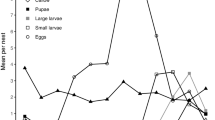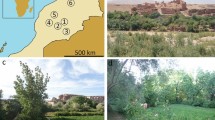Summary
Previous studies of the allodapine beeExoneura bicolor have utilised a predominantly social population from tall montane forests. In this report we examine aspects of the sociality and biology of a population from subcoastal heathland in western Victoria, Australia. Entire colonies, nesting inXanthorrhoea minor, were collected at monthly intervals over 12 months between February 1989 and January 1990. In addition, three collections fromMelaleuca squarrosa were made over three consecutive winter months. The heathland population differs from the montane population in several aspects associated with sociality: (i) it shows lower levels of co-occupancy in both newly founded and re-used nests; (ii) foundress dispersal occurs over a larger proportion of the year; and (iii) there may be a partical second brood produced in late summer, during and after adult eclosion of the first brood. The occurrence of a partial second brood gives rise to opportunities for sib-rearing and eusociality. Colony sizes tend to be larger inM. squarrosa thanX. minor, but still smaller than colonies from the montane population. Egg-laying commences several weeks earlier in multifemale colonies than in single female colonies, before spring dispersal begins. It appears that multifemale colonies are more successful at preventing brood loss than single females and that the mean number of brood per female is larger in multifemale colonies than in single female colonies. These two populations, which display differences in several life history traits, provide an ideal system for studying the mechanisms maintaining social behavior.
Similar content being viewed by others
References
Blows, M. W., 1988.Population structure and kin recognition in the allodapine bee Exoneura bicolor Smith (Hymenoptera: Xylocopinae). Unpublished BSc. (Hons.) thesis, Department of Zoology, La Trobe University, Australia.
Blows, M.W. and M. P. Schwarz, 1991. Spatial distribution of a primitively social bee: Does population genetic structure facilitate altruism?Evolution 45:680–693.
Gamboa, G. J., 1980. Comparative timing of brood development between multiple and singlefoundress colonies of the paper wasp,Polistes metricus.Ecol. Entomol. 5:211–225.
Hamiton, W. D., 1964. The genetical evolution of social behavior. I & II.J. Theor. Biol. 7:1–52.
Hurst, P. S., 1993.Reproductive hierarchies in an Australian allodapine bee, Exoneura bicolor Smith (Anthophoridae, Xylocopinae). Unpublished BSc. (Hons.) thesis, Department of Zoology, La Trobe University, Australia.
Lin, N. and C. D. Michener, 1972. Evolution of sociality in insects.Q. Rev. Biol 47:131–159.
Maeta, Y., S. F. Sakagami and C. D. Michener, 1992. Laboratory studies on the behavior and colony structure ofBraunsapis hewitti, a xylocopine bee from Taiwan (Hymenoptera: Anthophoridae).Univ. Kansas Sci. Bull 54:289–333.
Michener, C. D., 1965. A Classification of the Bees of the Australian and South Pacific Regions.Bull. Am. Mus. Nat. Hist Vol. 130.
Michener, C. D., 1965b. The life cycle and social organization of bees of the genusExoneura and their parasiteInquilina.Univ. Kansas Sci. Bull. 46:317–358.
Michener, C. D., 1971. Biologies of African allodapine bees (Hymenoptera, Xylocopinae).Bull. Am. Mus. Nat. Hist. 145:219–302.
Michener, C. D., 1974.Social Behavior of the Bees. Harvard University Press: Cambridge.
Michener, C. D., 1975. A taxonomic study of African allodapine bees (Hymenoptera, Anthophoridae, Ceratinini).Bull Am. Mus. Nat. Hist. 155:71–240.
Michener, C. D., 1990. Castes in xylocopine bees. In:Social Insects, an Evolutionary Approach to Castes and Reproduction. (W. Engels, ed.). Springer-Verlag, Berlin, pp. 123–146.
Michener, C. D. and F. D. Bennett, 1977. Geographical variation in nesting biology and social organisation ofHalictus ligatus.U. Kansas Sci. Bull. 51:233–260.
Packer, L., 1986. The social organisation ofHalictus ligatus (Hymenoptera; Halictidae) in southern Ontario.Can. J. Zool 64:2317–2324.
Packer, L., 1990. Solitary and eusocial nests in a population ofAugochlorella striata (Provancher) (Hymenoptera: Halictidae) at the northern edge of its range.Behav. Ecol. Sociobiol 27:339–344.
Packer, L. and G. Knerer, 1986. The biology of a subtropical population ofHalictus ligatus Say (Hymenoptera: Halictidae).Behav. Ecol Sociobiol. 18:363–375.
O'Keefe, K. J. and M. P. Schwarz, 1990. Pheromones are implicated in reproductive differentiation in a primitively social bee.Naturwissenschaften 77:83–86.
Rayment, T., 1953.Bees of the Portland District. Portland Field Naturalists' Club, Vic., Aust. 39pp.
Schwarz, M. P., 1982.Life-cycle and social organisation in the allodapine bee Exoneura (Exoneura) bicolor Smith (Hymenoptera: Apoidea: Xylocopidae). B. Sc. (Hons) thesis, Zoology dept, Monash University, Clayton, Australia.
Schwarz, M. P., 1986. Persistent multifemale nests in an Australian Allodapine bee,Exoneura bicolor (Hymenoptera, Anthophoridae).Ins. Soc. 33:258–277.
Schwarz, M. P., 1987. Intra-colony relatedness and sociality in the allodapine beeExoneura bicolor.Behav. Ecol. Sociobiol 21:387–392.
Schwarz, M. P., 1988. Intra-specific mutualism and kin-association of co-foundresses in allodapine bees.Monit. Ital Zool. 22:245–254.
Schwarz, M. P., 1994. Female biased sex ratios in a facultatively social bee and their implications for social evolution.Evolution in press.
Schwarz, M. P. and K. J. O'Keefe, 1991. Cooperative nesting and ovarian development in females of the predominantly social beeExoneura bicolor Smith (Hymenoptera: Anthophoridae) after forced solitary eclosion.J. Aust. ent. Soc. 30:251–255.
Silberbauer, L. X., 1989.The life-cycle and reproductive division of labour of a heathland population of Exoneura, with further investigation into the action of an ovarian inhibition pheromone. Unpubl. B. Sc. (Hons.) thesis, Department of Zoology, La Trobe University, Bundoora, Australia.
Trivers, R. L. and H. Hare, 1976. Haplodiploidy and the evolution of the social insects.Science 191:249–263.
Wcislo, W. T., 1989. Behavioral environments and evolutionary change.Ann. Rev. Ecol. Syst. 20:137–169.
West-Eberhard, M. J., 1975. The evolution of social behavior by kin selection.Q. Rev. Biol. 50:1–33.
West-Eberhard, M. J., 1987. Flexible strategy and social evolution. In:Animal Societies: Theories and Facts. (Y. Ito, J. L. Brown and J. Kikkawa, eds.). Tokyo, Japan Sci. Soc. pp. 35–51.
Wilson, E. O., 1971.The Insect Societies. Harvard University Press: Cambridge.
Wilson, E. O., 1975.Sociobiology. Harvard University Press: Cambridge.
Author information
Authors and Affiliations
Rights and permissions
About this article
Cite this article
Silberbauer, L.X., Schwarz, M.P. Life cycle and social behavior in a heathland population of the allodapine bee,Exoneura bicolor (Hymenoptera: Apidae). Ins. Soc 42, 201–218 (1995). https://doi.org/10.1007/BF01242455
Received:
Revised:
Accepted:
Issue Date:
DOI: https://doi.org/10.1007/BF01242455




